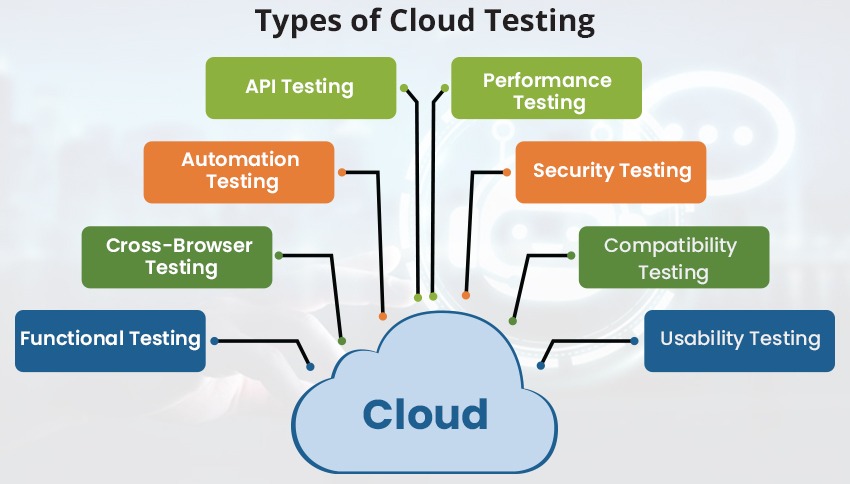- November 7, 2024

Cloud-based testing services for web applications refer to the verification of software quality on a real device cloud. Cloud-based testing services enhance application performance, scalability, and reliability, making them essential in the rapidly evolving cloud landscape. Offered through models such as Infrastructure as a Service (IaaS) and Platform as a Service (PaaS), these services provide a secure testing environment. Cloud testing services guarantee that the web applications meet the highest levels of security, quality, and performance standards. They make use of the latest tools and methodologies to assess and validate cloud-based solutions, enabling enterprises to focus on business growth and innovation. In this blog, you will learn the benefits of adopting cloud testing services for your enterprise along with an overview of different types of testing.
Table of Contents
Benefits of Cloud Testing Services for Web Applications
Cloud-based testing services, performed through cloud computing, intend to test the software on the basis of its functional and non-functional requirements.
Its inherent benefits are as follows,
A 2024 study by Gartner found that companies using cloud testing services reported an average cost reduction of 30-40% compared to on-premises testing.
- Cloud-based testing services enhance product quality and help uncover hidden product issues to ensure flawless performance in real-world scenarios.
- It speeds up software development cycles and accelerates time to market with parallel testing and CI integration.
- It is a cost-efficient model; it reduces expenses and eliminates the need for costly infrastructure.
- Cloud-based testing is a scalable solution that adjusts testing to suit any user base.
- With its reliable performance, it identifies and resolves potential bottlenecks for application reliability.
- It adheres to stringent security measures and compliance standards.
- Cloud-based testing enhances customer trust and improves competitive edge, helping to build a robust and high-quality product.
- With the help of collaborative testing, distributed teams will be enabled to access cloud testing environments and resources in real time.
- It offers tailored solutions that can align with the product and project needs.
- With its global accessibility standards, it is possible to test software from anywhere and anytime.
Types of Cloud Testing
The cloud-based testing services are designed to address the unique challenges and opportunities with respect to cloud environments. The testing scenario will focus on delivering comprehensive cloud testing, thus encompassing everything starting from performance to functional testing to substantiate compliance and security checks.
The types of cloud testing are as follows,

- Functional Testing: Focuses on traditional functional tests, including integration, unit, and acceptance testing, with respect to cloud environments.
- Cross-Browser Testing: Ensures the compatibility of web applications across different browsers using cloud-based services.
- Automation Testing: It makes use of automation to expedite testing in cloud testing, thus achieving rapid and consistent results.
- API Testing: Focuses on API functionality, security, and reliability in real-time cloud-based applications.
- Performance Testing: Leverages cloud resources for stress, load, and different types of scalability testing.
- Security Testing: It conducts both penetration tests and vulnerability assessments to enhance the defenses of the application.
- Compatibility Testing: These types of testing will assess the device and the compatibility of the diverse operating systems for the mobile applications.
- Usability Testing: It helps evaluate the user interface and experience with the help of user feedback in different locations.
Cloud-Based Testing Services – Best Practices
As you know cloud-based testing is the game-changer in the software testing landscape, still, it requires some strategic plan to effectively leverage the platform. Here we have listed some best practices and methods for you.
- Evaluate the load testing models and Tools: Address their key features such as upload and download speeds, bandwidth simulation, etc, and ensure they stay in tune with the load limits.
- Automation and Scheduling: Choose the load testing tools that have built-in features like analytics, scheduling, reporting, etc. After completion of the tests, the tools should share comprehensive reports with the respective stakeholders.
- Conduct Tests outside and inside the Firewall: In instances of poor app performance, the cloud-based testing system should encompass testing inside and outside the test wall to identify and fix bottlenecks.
- Simulate Real-World Conditions: The load testing environment should offer a diverse range of test scenarios, keeping the user load at the base level, with many different configurations.
- Prioritizing Bugs: To maximize the value of cloud performance testing, the testing should focus on bugs and take strategic steps to reap maximum ROI from the testing efforts.
- Considering all the Users and Servers: Generally, the performance tests will be focused on the clusters and servers. However, for comprehensive testing, the tests should also encompass the human element.
Preparing for Cloud-Based Testing
There are a number of tests that are to be adopted to prepare for cloud-based software testing. By preparing through these steps, it can be ensured that cloud-based testing is well-prepared and will run smoothly.
- Before starting the cloud-based testing process, it is mandatory to equip oneself with the cloud-testing platform tool that will be used. This involves familiarizing oneself with the required documents, watching the required tutorials, and working through the sample tests.
- It is also important to have stable and reliable internet connections. Cloud-based testing relies predominantly on this ability.
- The third most important step in preparing for cloud testing invoices, installing the software, and setting up important and critical credentials are also important.
- The next step is to create test cases and test data. Before starting with cloud-based testing, it is pertinent to know clearly how to test and what to test.
- Setting up the monitoring and reporting process is the next step. It is necessary to track the progress of the testing and also measure the results.
- Virtual machines can also be used for testing. These virtual machines can be valuable tools for the process of cloud-based testing, as they allow to configure and create a testing cloud environment, without having to set up a physical test lab.
- Above all, it is important to plan for potential issues. A number of issues might arise during the testing phase such as software bugs and network issues. Thus it is mandatory to be ready for troubleshooting and issues resolving as and when they arise.
TestWheel’s Tailored Testing Solutions
At TestWheel we follow customized testing strategies that align perfectly well with the project requirements. We ensure that the testing process is made as effective and efficient as possible while concurrently identifying and addressing issues at the earliest. Our testing methodologies are designed to integrate seamlessly with the existing workflows and software development cycles. We offer cost-effective testing solutions that derive higher ROI for the business while helping them to save costs and enhance the quality of their software.

